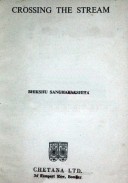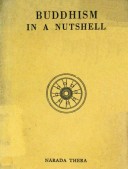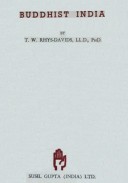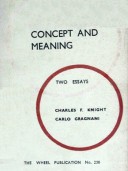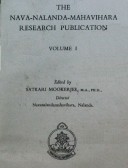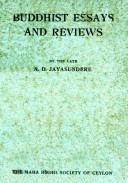Tìm Sách
Sách tiếng Anh-English >> The Path of Discrimination
Thông tin tra cứu
- Tên sách : The Path of Discrimination
- Tác giả : Bhikkhu Nanamoli
- Dịch giả :
- Ngôn ngữ : Anh
- Số trang : 446
- Nhà xuất bản : The Pali Text Society
- Năm xuất bản : 1997
- Phân loại : Sách tiếng Anh-English
- MCB : 12100000011636
- OPAC :
- Tóm tắt :
INTRODUCTION BY PTS EDITOR
According to ftanamoli’s note on his typed draft, this translation was made in 1955, between June and October. It was thus done after his translation of the Visuddhimagga was drafted (1953) but before it was finally revised and published (1956). His translations later published by the Pali Text Society, Minor Readings and Illustrator, The Guide, Pitaka- Disclosure, were evidently made after that, since they adopt a new ‘scheme’ of translation.
Nanamoli’s typescript was sent to the President of the Society in 1961 by Nãnãloka Mahathera, a year after the translator’s death. This typescript is single spaced, without margins and with thousands of revisions handwritten in ink over the fainter typescript or in spaces between the paragraphs. It was impossible for a compositor to follow. The footnotes and other accessory material, mostly handwritten on separate sheets and scraps of paper, required deciphering and placing. To our regret, more than one start was made on preparing a copy for printing by different PTS editors, who found the task too heavy and gave up after much loss of time. Apart from the physical difficulty of handling the text, it was found that the revisions were incompletely carried out, so that the translation itself would have to be corrected according to the translator’s intentions. As for the retyping, it was once hoped that this difficult transcription could be done gradually ‘on the side’ by the editorial secretary of the PTC staff in Toronto. That hope was frustrated by a research assistant who spent much of his PTC time on his own private work and turned in insufficient Concordance material, hastily and carelessly compiled. The secretary consequently had to deputise for him in making up deficiencies, correcting his Pali and verifying the references. He was duly ‘replaced’, but by then the supporting agency had suggested that a computer should be used for PTC. The editor of Vol. m, after research on this technique, agreed that the Concordance could thereby be made much more complete and accurate and worked out an appropriate programme. That the use of a computer was then vetoed by I. B. Homer is another story, but in any case the computerised project allowed no slack periods for its staff to fill in with other research. The Path of Discrimination had to become a separate and substantial project.
Amid the distractions of other research commitments and the rough and tumble of ‘academic’ life in North America, the present editor suffered further delay before he was able to set aside a few months to prepare the work in time for the Society’s centenary. He obtained a small grant for paying a typist from the University of Toronto’s Research Board, in order to prepare a copy which a compositor could follow. Now at last, after the eye-straining labour of checking that, restoring numerous lines lost in copying from the maze of single spaced typing, adding the notes and, we hope, carrying to completion Nanamoli’s latest intentions regarding his translations of terms, The Path of Discrimination may take the place of honour it deserves among the Society’s publications.
During the last months of his life, Nãnamoli was working on his translation of the Petakopadesay finalising it for publication by the Society, The Guide being then in the press. Thus he could have had no time to make his final revisions to The Path of Discriminationy, nor to write an introduction to it. Nevertheless he appears to have turned to the Patisambhidãmagga from time to time during his final year or two and revised its translation, even introducing some new English equivalents not found in his other works. We can perhaps even discern a new ‘scheme’, as he called his systems of translation, practically evolved here, though of course it is impossible to know whether he would have carried his revisions substantially further. This being the only canonical Pali text he is known to have translated, it is possible he found such a new scheme desirable for it. Something will be said on his method of translation and on his equivalents for particular terms at the end of this Introduction, by way of leading in to his text. It should be stated at the outset, however, that our aim is to present his text exactly as he left it, making only corrections he himself evidently intended to make. For example, since he changed ‘consciousness’ and ‘mind’ to ‘cognizance’ in almost all the places where they stood for citta (but not where they stood respectively for vinnana and mano), we have changed them likewise in a few places he missed in his revision, Nãnamoli being a protagonist of absolute consistency in such matters. Likewise a note of his found on a slip among the pages of his draft authorises us to change ‘dear-vision’ to ‘recognition’ where it stands for vijja as a technical term (but not in other places where he renders it ‘science’) and confirms nine other changes of translation carried out, but incompletely, by him over his typescript. His Index, made at a relatively early stage, was largely unrevised and had therefore to be brought into consistency with his text. Altogether the translations of about sixty words had to be corrected in this way according to Nanamoli’s evident intentions. There may be a few more which have escaped notice. In the few places where the editor has added anything with less than certainty about Nanamoli’s intentions or wording, or restored a phrase missing from the translation, it has been enclosed in <pointed brackets>. Nanamoli’s own insertions, such as headings, are enclosed in [square brackets]. He enclosed alternative renderings and Pali words in (round brackets). All references to other texts, whether Nanamoli’s or added by the editor, are enclosed in round brackets.
It is obvious from his other books that Nanamoli would have written a long introduction to this translation. Such an introduction is all the more desirable in the present case on account of the dryness of the work, the richness and depth of whose content is not at all apparent on the monotonously repetitive surface, which has the texture of a ploughed field. This was certainly a text composed for oral tradition, to be memorised and chanted, not for the analytic presentation of a written document. But it is none the less analytical for its presentation, and none the less juicy (rasavant in both the senses we shall discuss below) for its hard coconutlike shell. We cannot hope to emulate what Nanamoli would have written, but we have some of his ideas about this text before us in his notes to it to guide us and here and there something about it in his other writings, such as The Path of Purification which is so closely related to it. We can see from his Introduction to that translation that he would have tried to place the Patisambhidămagga among the ‘trends* (p.xxviii) in Theravãda doctrine and if possible in the history of Buddhism as a whole (p.xxx). With that inspiration given by him we have attempted to make good the deficiency, to place the Patisambhidãmagga and to offer the reader or student an axe, however crude, to cleave it open and taste its liberating juice.
The ‘Discriminations’ and the Patisambhidãmagga
‘Discrimination’ (patisambhidă), or ‘comprehension’ as we have elsewhere rendered it, is not one of the most conspicuous of the terms of early Buddhism and the Pali Canon. According to the references collected in the Pali Tipitakam Concordance, Vol. Ill s.v. (cf. Vol. I under attha, etc.), the term ‘discrimination’ ịpatisambhidă) does not occur in the Digha, Majjhima and Samyutta Nikãyas but does occur several times in the Anguttarat which on other grounds appears to be later than the first three or at least to have been more open to the insertion of new suttas (I[ndian] B [uddhism] p.203). Similarly the term appears in the Parivãra but not in the preceding volumes of the Vinaya. In the Khuddaka Nikãya, patisambhidã is familiar to the Niddesa, Apadãna and Buddhavamsa, besides the Patisambhidămagga itself, and in the Abhidhamma it is found in a chapter tacked on near the end of the Vibhanga and in the Kathãvatthu and Tikapatthăna.
This distribution is so striking that its chronological significance cannot be missed: even those who believe literally that the Buddha himself composed or approved the whole Tipitaka, and that Sriputta composed the Patisambhidamagga, as tradition has it, must see here a development of thought, a comment at least on an earlier statement, namely on the Dhamma- cakkappavattana Suttanta, the Buddha’s first exposition of his doctrine.
The term ‘discrimination’ is not unknown to other schools of Buddhism, however, though when it appears in Sanskrit iris given a different root (pratisamvid), so it is not a late invention of the Theravadins and probably became current during the period of the great schisms which produced the Eighteen Schools (B.c. 349 to B.c. 50 according to IB pp.214 and 288, etc.). Thus the later Sabbatthỉvãdin text Prakaranapăda (Taishõ 154Ỉ and 1542, Chapter VI, No. 12 among the Fours) and the still later Bahussutika *Tattvasìddhisãstra (Taishõ 1646, p.368 b-c) have the four ‘discriminations’. But the topic is quite inconspicuous in these schools and might even be suspected of being a later borrowing from the Theravãda. We do not at present know whether their Suttantas contained the term, but according to Akanuma, p. 136, the Chinese version of the Ekottara Ẵgama (Taishõ 125) contains a text corresponding to A ii 160 (see below, it is No. 173 of the Fours, as Akanuma identifies it; this Ekottara appears to belong to the Dhammaguttika School, IB p.8).
Returning to the Pali, we find in the Anguttara that the tathãgata has ‘eye’ (insight, cakkhu), ‘light’ (aloha), ‘illumination’ (obhãsa), etc., and ‘realizes’ the four discriminations (cf. iv 32-3) and the fruit of arahantship (i 22-3). Mahãkotthita was the foremost of those who had attained the discriminations (i 24). It is impossible that there should be ‘exhaustion’ from the point of view of ‘meanings’ (attha) or ‘expressions’ (vyanjana) in one endowed with the four discriminations (ii 139). This implies that they represent a certain power of understanding or marshalling words and meanings. Sãriputta realized the four discriminations a fortnight after his ‘entrance’ into the Community and could thus explain any doubts, etc.: one who is (thus) skilled in dhammas (‘principles’, ‘ideas’) is our teacher (the Buddha) become present (ii 160). It is odd that, after these two mentions in the Fours, we find two in the Fives: the discriminations with either ‘skill in helping colleagues’ or ‘he reviews cognizance as it is liberated’ (adopting Nanamoli’s equivalents) as the fifth (iii 113 and 120).
The starting point for the development of the conception of the four discriminations, however, may be seen in a context where the term itself does not occur but significantly three of what came to be known as the discriminations are connected, namely leaning’ (attha), ‘principle’ (dhamma, ftinamoli’s ‘idea’) and ‘language’ (nirutti). ‘Expression’ (vyan- jana) and ‘context’ (pubbăpara) are added to these three and it is said that a monk must be skilled in all five in order to learn quickly, etc. (iii 201). The Commentary here rather oddly explains attha as Atthakathã and dhamma as the Pãịi, but that surely is wide of the maik in a dialogue between ssriputta and Ảnanda and looks like a poor guess made in the absence of the clarifying term ‘discrimination’ (AA iii 300).
The Niddesa, or properly Mahăniddesa, is one of the latest additions to the Suttanta, being a commentary on parts of the Suttanipăta. It includes having acquired the four discriminations among the qualities of the Bhagavant (i 143,212, 338, ii 216, similar are i 481, 310, ii 51, 135). Then being patibhãnavant, ‘possessing intuition’ (ftenamoli ‘perspicuity’), which is the fourth discrimination, is said to be of three kinds, in learning (simply), in inquiry (about meanings, definitions, causes, etc.) and in acquisition (of the thirty-seven principles on the side of enlightenment, the four fruits of being a samana, the four discriminations and the six ‘direct knowledges’, abhinnas). This last is significantly stated to be because one knows the ‘meaning’ (iattha), the principle or ‘idea* (dhamma) and the language (nirutti) and they are clear to ịpati-bhã, or ‘inspire’) one; therefore, patibhănapatisambhidă (‘discrimination of perspicuity’ or ‘comprehension of the intuition’) being knowledge with reference to these three, one is calledpatibhãnavant (i 234-5, ii 192-3). This seems to show the origin of the fourth ‘discrimination’.
In the Apadãna (31, etc.) we read that sriputta and others had realized the four discriminations, eight liberations and six direct knowledges. In the Buddhavamsa (23) we appear to have a versification of the passage just summarised from the Niddesa (i 234-5, ii 192-3).
In the Parivăra (Vin V 197) it is laid down that the nuns should not talk with a monk who has not attained the four discriminations (amongst other deficiencies; i.e. they should not accept his admonitions). This is immediately followed by the statement that a monk should not be elected to a committee if he is not skilled in meanings, principles (ideas), language, expression and context (just as in A iii 201 above). Placing these two statements side by side seems to confirm our idea above that this Anguttara context should be understood as a parallel to the discriminations (expression can be included in language, context in that or meaning), or as their prototype.
The Patthãna reference noted in the Concordance states that through the ‘immediate dependence’ (upanissaya) condition one sees impermanence, unhappiness and non-soul (the three universal characteristics of all principles) and acquires the four discriminations, as an effect of the arahantpath (TkP 167). This associates the discriminations with enlightenment.
The Kathãvatthu (309ÍT.) refutes the opinion of the Andhaka Schools (according to its Commentary) that all knowledge is ‘discrimination’. It is interesting that the Andhakas (CetiyavSdins presumably, or their offshoots the Pubbaseliyas and Aparaseliyas) recognised discrimination’, though they appear to have downgraded its significance compared with the Theravãdins. The term continued in circulation in the Mahăyãna, for example in the Sukhãvatĩvyũha (IB p.360), which appears to have developed out of the Pubbaseliya School (IB pp.353-4).
The Vibhanga Chapter (XV) on the discriminations (293-305) explains the four discriminations attha, dhamma, nirutti and patibhăna, this being the standard order just as we have seen it in the texts examined above. The first discrimination is ‘knowledge’ (năna) about (locative case) the attha and the second likewise about the dhamma. The third is knowledge about the ‘appellation’ (abhiỉãpa) in the language about the dhamma. The fourth is knowledge about these three knowledges. Then the first is knowledge about unhappiness and the second about the origination of unhappiness (the first two truths or ‘actualities’). The first is also knowledge about the cessation of unhappiness and the second about the way leading to this. This suggests that attha is about results or effects, dhamma about causes, which we shall find confirmed further on. The third discrimination is always described simply as about the appellation in the language about the dhamma and the fourth as knowledge about the knowledges. It is the first two which are problematic.
The Vibhafiga goes on that discrimination of dhamma (stated first in this explanation) is knowledge about the cause (hetu). Discrimination of attha is knowledge about the effect (phala, ‘fruit’) of the cause. Discrimination of attha (put first again) is knowledge about the dhammas (plural) which have been produced, discrimination of dhamma is knowledge about the dhammas (plural) by which these dhammas have been produced. This very clearly suggests that all discrimination is about dhammas (the plurality of principles or ‘ideas’), but that the discrimination of attha concerns dhammas as effects whereas the discrimination of dhamma considers them as causes. We observe that all dhammas are in fact effects of other dhammas and all likewise, except presumably nibbãna itself, though even that may serve as a condition, are causes. So it is simply the standpoint which is different, not the object itself but whether it is contemplated as cause or as effect.
But the Vibhanga then appends a quite different explanation of the ambiguous terms dhamma and attha (again the order is reversed). Dhamma means the texts or doctrine: sutta, geyya, veỵyãkarana, etc. Attha is the ‘meaning’ (attha) of whatever of that (dhamma) has been spoken. The explanations so far are called the suttantabhajaniya section, though they are hardly to be found in the Suttanta. This name really refers to the archaic ‘without question’ method of elaborating an abhidhamma text (see below).
In the abhidhammabhajaniya which follows, the questions relate the discriminations to dhammas as ‘good’ (kus ala) and so on. Attha as before is about their result, here called vipăka. It is added that discrimination of language is knowledge about the appellation in the language about the dhamma(s), by which language there is a ‘concept’ (panHatti) of those dhammas (previously discriminated by the discrimination of dhammas). Discrimination of patibhãna or ‘perspicuity’ is knowledge about knowledges, which is ‘illuminations’ by which one knows these knowledges. In the case of a ‘result’ which is ‘indeterminate’ (produces no further effect) only three discriminations apply, discrimination of dhamma being inapplicable obviously because it concerns causes (p.297).
Thus the Vibhatiga does not quite resolve the ambiguity of both attha and dhamma but suggests that in each case both meanings may apply. Attha is either ‘effect’ or ‘meaning’. Dhamma is either ‘principle’ or ‘doctrine’, the ‘principles’ being the real elements which compose the entire universe or samara and all our experience in it (see IB2 pp.97-9, in IB1 they were called simply ‘phenomena’, fianamoli here uses ‘ideas’ as translation). As an effect, attha might be translated ‘purpose’ or ‘objective’ or simply ‘object’. The ‘object’ of all the principles, except nibbãna, is then more principles, more occurrences of principles (since all are momentary, not enduring substances), the continuation of the universe and of ‘transmigration’ or rebirth in it. On the other hand, we may add, the ‘object’ of knowing the principles and the truths or ‘actualities’ is nibbăna.
Nãnamoli has consistently translated attha as ‘meaning’ and dhamma as ‘idea’. The reader should therefore bear in mind the ambiguity, the overtone, so to say, of ‘objective’ in attha. On ‘idea’ we shall have more to say below. In favour of ftanamoli’s interpretation we may note that the Patisambhidămagga, unlike the Vibhanga, seems nowhere to explain that attha may mean an effect or object. Indeed it appears to take the meanings of the four discriminations for granted, as already known or self-evident. Does it presuppose the explanations given in the Vibhanga or is it independent of them, having possibly been composed before that chapter of the Vibhangal.
In its Treatise (XVI) on the discriminations the Patisambhidămagga significantly reverses the order of attha and dhamma when describing them, after first enumerating them in the customary order (ii 150), just as the Vibhahga does. But the description is merely a list of dhammas, then a list of atthas. Instead of the discrimination of language being the appellation in the language about the dhamma’ it is here the ‘appellation in the language of the expression (vyaiijanay showing both dhammas and atthas. The earlier description in the Treatise on Knowledges (I 88-91), where the four are also called ‘understandings’, is similar. What we learn is that the dhammas are eye, knowledge, understanding, recognition (yijjai), light (ãloka), also the five faculties, the powers, the seven factors of enlightenment, the eight factors of the way (i 88-90) and others implied by the description in Treatise XVI. The atthas are the attha (meaning?) of seeing, that of having known, that of understanding, that of penetration, that of illumination (obhãsa), those of intentness, applying, basis, non-diflusion, unshakability, discrimination (pavicaya), pervading, calm, consideration, implanting, possessing, rising from, cleansing and no doubt others, all with reference to corresponding dhammas. We may gather from these that an attha is a process, or the functioning of a dhamma (and might revise our translations accordingly). Such a function or process perhaps indicates an objective or purpose, an object of the dhamma. If it is the corresponding ‘meaning’, it is so only in a very broad sense, which we might call the ‘significance’ of a dhamma, attempting to bridge the gap between ‘meaning’ and ‘object’ (at some stage in the history or prehistory of Pali there was presumably no gap). The Patisambhidãmagga, however, does not seem to contemplate attha in the same way as the Vibhatiga, where an attha seems to be primarily a dhamma considered as an effect instead of as a cause (we are not yet following Mahanama’s Commentary, which applies the Vibhanga account to the Patisambhidãmagga and quotes it at length, pp.3-5). Thus it appears to be independent of the Vibhanga theory, or to represent an earlier stage in the development of the conception of the discriminations.
The Nature of the Patisambhidămagga
The Patisambhidamagga is insistently practical: it expounds the way or path of ‘discrimination* in its various aspects and tries to show exactly how understanding takes place in a practical sense, not simply in theory. What happens, and how does it happen, when someone understands or comprehends or ‘discriminates’ the truth or ‘actuality* taught by the Buddha? The theory is of course necessary, the understanding or insight, and is included in this path, as well as the practice in the limited sense of concentration, the calming or ‘serenity’ (,samatha) as our text prefers to call it. The pair, insight (vipassanã) and serenity, which must be ‘coupled’ (yuganandha) and function together, are here presented as fundamental. Enlightenment, as Ảnanda said (ii 92, quoted here from the Yuganandha Suttanta, A ii 156), requires both serenity and insight and no one has attained it without these two. In fact they cannot be perfected separately: concentration (serenity) can be perfect only when made steady by the understanding of (insight into) dhammas as impermanent, painful and not self (later called the three universal characteristics of all principles); but insight becomes perfect only when ‘cognizance’ is totally calm because of serenity. With such an underlying conception, and with all the ‘actualities’ penetrated simultaneously by ‘discrimination’, the presentation here is extremely systematic and everything is brought into relation with everything else.
The Philosophy
Though this book is thus strictly practical, it presents a practice which is possible only when the practitioner understands the nature of reality, as has just been indicated, its nature as taught in Theravãda tradition and by the Buddha himself. The essence of this philosophy, as stressed here, but taken from one of the most famous discourses of the Buddha (Vin i 14 and s iii 67f., immediately preceded by Vin i 13f. and s iii 66f. elaborating the same topic), is the knowledge of impermanence, unhappiness (pain) and non-soul (not self). These are the characteristics of the five groups or ‘aggregates’ of principles, of which everything in our experience, except nibbăna, is made up (samkhata, ‘synthesised’, ‘formed’). Though all three are stressed in the Patisambhidămagga, the insistence on non-soul is perhaps the most striking and the most philosophically profound. It also appears as primary: it is because there is no ‘soul’ or substance or permanent ‘being’ that all ‘existence’ is impermanent and also that it is fundamentally unhappiness or ‘pain’ or ‘suffering’ (the more universal ‘unhappiness’ seems a closer equivalent to the Pali dukkha, which moreover is opposed to ‘happiness’, sukha; Nanamoli prefers ‘pain’).
This doctrine of non-soul is the Buddha’s original critique of all philosophy, of all concepts of supposed entities which in fact are not entities, of all propositions about such supposed entities, which are false or, rather, meaningless. There are no entities (permanent beings or substances or souls), there are only the dhammas, principles which are impermanent, unstable and ‘empty’. By ‘empty’ the Buddha means, besides the absence of a permanent entity in them, that they are conditioned or relative (to one another), which is an equivalent statement. Of all the Pali texts, the Patirambhidămagga deals most elaborately with the topic of the universe, ‘forces’, dhammas, being ‘empty’ (ftenamoli prefers ‘void’).
Directly linked to the theory of non-soul is that of the dhammas in the sense of ‘principles’, which we have encountered above among the four discriminations. The Buddha himself does not seem to have stated that the only realities are the ‘principles’ (and nibbăna), but this is clearly implied by many of his statements recorded in the Suttanta. What he does discuss is the nature of these principles, the absence of a ‘soul* from them and so on.
In the Dasuttara Suttanta of the Dĩgha Nikãya, which actually forms the starting point for the exposition in the Patisambhidămagga, 550 dhammas are set out and all said to be ‘real’ (bhũta; there is much duplication among these sets of dhammas, so that their number could be greatly reduced in Theravada philosophy later). In the Potthapăda Suttanta of the same Nikãya the Buddha says he ‘makes known the practice which is real, true, thus, stationed among the dhammas and being through the regularity of the dhammas’ (D i 190). This ‘regularity’ is one of the grand hypotheses of the Buddha, the foundation of the practice as of the theory. In the Nidãna Samyutta we read: ‘This dhătu (element, principle, base) is established, there is a station for dhammas, there is regularity of dhammas, there is specific conditionality. This a thus-gone attains enlightenment about’ (S ii 25). A dhãtu is simply another dhamma, when considered as the specific condition for a particular dhamma to occur, its source or ‘ore’. From this regularity arises the conception of the dhammaness, dhammatã, as the natural tendency of certain dhammas to lead to others, for example of happiness to lead to concentration, of concentration to lead to knowing reality as it is (A v 2-4).
The other great hypothesis about the dhammas is that of their impermanence, etc., which in fact is presented not as a hypothesis but as a direct observation. It is of course closely related to the preceding hypothesis, which concerns the changes, the flux, among the dhammas, which nevertheless is perceived as regular. The dhammas which are included in the five groups (aggregates) are to be seen as impermanent, unhappy, sick, etc., and as empty and without soul (M i 435). One should see all dhammas as without soul in Older to attain nibbãna (A iv 14). ‘This dhãtu is established, there is a station for dhammas, there is regularity of dhammas, all forces (samkhãras) are impermanent… this dhãtu is established … all forces are unhappy… this dhãtu is established … all dhammas are without soul’ (A i 286). In this last text the hypotheses of regularity and impermanence, etc., are combined. The ‘forces’ themselves are dhammas, sometimes in fact all dhammas but sometimes confined to the one group of‘forces’ among the five groups. (ftinamoli calls them ‘formations’.)
The dhammas as seen by the Buddha are thus not just raw data of experience but a set of hypotheses about them. Moreover most raw data, such as colours and most everyday objects, persons and so on are not dhammas, which are the more fundamental forces, the elemental or primary forces, not the infinite variety of the surface of things. The dhamma theory thus resembles the chemical theory of elements, of a hundred or so more ultimate realities making up the innumerable compounds and everyday objects we superficially perceive. The dhammas of the Buddha are physical (in the first ‘aggregate’, namely ‘materiality’: ‘earth’, ‘water’, etc., and the physical senses) as well as mental. The striking of a physical sense against an object is not a separate dhamma, but if such an experience is reflected into thought it produces ‘contact’ (Mi 111, Ps i 22), which is a mental dhamma. It is a force producing further mental dhammas such as pleasure, pain, perception (awareness or recognition of an object), volition, desire, aversion, etc.
The Buddha’s discourses on these realities are thoroughly deperson- ified (see the article ‘The Concept of a Concept’, Journal of Indian Philosophy, 1971, 181ff., on this). Thus when he was asked ‘Who eats the consciousness food?’ (this ‘food’ is previous consciousness, previous mental experience) he replied: ‘Not a sound question. I do not say ‘eats’… If you were to ask ‘of what’ is it consciousness food, that would be a sound question. The consciousness food is the condition for the future production of rebirth.’ (S ii 13; IB p.119). We can sum up by saying that in the Nidãna Samyutta (S ii 1-133) conditioned origination is opposed to all mistaken ideas of there being any permanent entities in the universe (the use of the term dhamma in the first four Nikãyas has been more fully reviewed in the article ‘Dharmas and Data’ in the Journal of Indian Philosophy, 1971, 278ff.). That this is an empiricist philosophy, not a speculative system, is everywhere stressed: the thus-gone holds no opinion at all, instead he has actually seen matter, experience, perception, forces and consciousness (the five aggregates) and their origination and cessation (M1486, IB 141).
Among the innumerable occurrences of the term dhamma in the Patisambhidãmagga, which presupposes the suttas we have just reviewed, may be noted its enumeration of 201 of them (by ftanamoli’s count) (i 5-8). The knowledge of there being a ‘station’ for dhammas is that of conditioned origination, their causal or conditional relationships (i 50-2). The dhammas (listed again) are impermanent, unhappy, non-soul. With understanding of these one acts appropriately and shows their ‘significance’ or ‘effects’ or ‘meanings’ (attha, i 104-5). A11 dhammas may be included in one in the sense that they are true, non-soul, etc. (i 105). By contemplating all dhammas as ‘alien’ {para) the thought understands emptiness and is liberated (ii 48). If a monk contemplates any dhamma as a soul (self, substance) it is not possible that he should make a ‘choice’ in conformity with reality and realize arahantship (li 237).
The system of categories of what can be known, which is implicit in the suttas, was worked out only later by Đuddhadatta (Abhidhammãvatãra) and others. It is still latent in the Patisambhìdãmagga. We have first the dhammas, real though unstable. Then there are ‘concepts’ (pannatti), unreal except to the extent that they may be names of dhammas (see IB2 110f., 150f.; in Ps for example at ii 195, but the term is not often used). Next there are the ‘characteristics’ (lakkhana) of the dhammas, which also are concepts in that they do not refer to any actual dhamma but only to the absence of soul, permanence or happiness in them and so on. Nevertheless they deal with reality in the sense of understanding it. In the Patisambhidãmagga the rise, fall and change of dhammas are ‘characteristics’ (ii 179), also ‘formed’ (all dhammas) and ‘unformed’ (inibbãnay ii 108). The term appears also at i 54ff, 167,191f. In the later system, just beginning to develop in the Patisambhidãmagga with the concept of ‘own nature’ (sabhãva, ii 178-9, see Nanamoli’s note 1 to Treatise XX), each dhamma is defined with a particular ‘characteristic’ peculiar to itself, in addition to the universal characteristics they all share. The fourth category of Buddha- datta is nibbăna. Sometimes the dhamma category is subdivided into physical and mental and in further ways. Mahãnẫma in his Commentary on the Patisambhidãmagga (p.58) adds a fifth category, namely ‘change’ (vikăra). This refers to the change inherent in all dhammas, the fact of conditioned origination as the universal law of their occurrence. This is perhaps especially appropriate in the philosophy of the Patisambhidamagga, where rise, fall and change are so much stressed. The fundamental categories in later Theravãda, however, are just the two: reality (dhammas and nibbăna) and concepts (words).
The theory of the four errors or ‘perversions’, which is conspicuous in the Patisambhidamagga (ii 80-1, etc.), is simply an extension of the three universal characteristics. These errors are taking unhappiness as happiness, impermanence as permanence and non-soul as an eternal soul. Taking ugliness or foulness as beauty is added as the fourth. All apply to the same data, the same experiences, the same world, wrongly perceived.
Again the numerous wrong views or opinions of Treatise II are all based on the original error of imagining a ‘soul’ or continuing entity in one’s experience. They are all said to reduce to the two fundamental mistakes of imagining such a soul as ‘eternal’ or imagining it as being ‘annihilated’ on the death of the body.
The fourth ‘discrimination’ of this book, the ‘knowledge about knowledges’, shows what might be called the epistemological inspiration of the whole work. To know that we know is to be certain of the knowledge we have (of dhamma, attha and language). Many other terms used here, especially ‘insight’, ‘understanding’, ‘convergence’ (abhisamaya), are equivalent to this knowledge or discrimination or ‘intuition’. This equivalence of a series of terms taken from the suttas is shown throughout the Patisambhidamagga and gives it unity.
Sabhăva and Rasa
Nanamoli’s note to Treatise XX referred to above points out that the term sabhãva, ‘own nature’ or ‘individual essence’, is rare in the Tipitaka, though a standard concept in the commentarial descriptions of the dhammas. He says he had not found it except here. However, it occurs in the Buddhavamsa (p. 15, u 167), surely one of the very latest texts added to the Canon (see Pali Metre p.225). Sabhãva is found there in a compound with two other late terms: ime dhamme sammasato sabhãvarasalakkhane
‘Of him comprehending these dhammas having their own natures, tastes and characteristics’. Obviously this presupposes the later system of describing dhammas according to their characteristics, ‘tastes’ (functions) and own natures, which is not actually found even in the Patisambhidamagga although all three terms occur here with these special technical meanings already developing. (Bhãva ‘causing to be’, ‘becoming’.)
Sabhãva is first explained, in available Theravãda texts, in the Peta- kopadesa (p.104), where in a discussion on conditioned origination it is said that the ‘cause’ (hetu) is the ‘own nature’ of a dhamma whereas the ‘condition’ (paccaya) is the ‘other nature’ (parabhãva). The own nature is thus the nature of the dhamma itself, as liable to occur in that situation, whilst the other nature is another dhamma which is the condition for it to occur. The own nature is further described as ‘internal’ to an individual stream of consciousness and the other nature as external (IB 318). In the commentaries dhamma as a term is defined as that which has its own own nature (IB 323; Atthasãlinĩ 39). The term ‘other nature’, however, is dropped and only a ‘condition’ is spoken of. ftanamoli in his note simply quotes Mah&nSma on sabhãva. There is a difficulty here in the Patisam- bhidãmagga, since it says that materiality (and other (void) by sabhãva, apparently contradicting the commentaries (though not the Tipitaka). Mahãnãma first suggests that empty by own nature means empty of any nature other than its own, which is hardly convincing. Then he tries ‘having emptiness as its own nature’, which is surely better since all the dhammas are empty of a soul or substance. He then rejects the argument that it means the dhammas are totally ‘empty, have no reality at all. Dhammas are real, do exist, though only momentarily.
We do not find the technical term rasa in this sense of ‘function’ even in the Petakopadesa when it defines dhammas (IB 319). This appears only in the commentaries as the function of each dhamma, for example that of ‘supporting’ in the case of ‘earth’ (IB 323). The Patisambhidamagga shows the term apparently in a transitional sense between that of ‘taste’ in the early suttas and that of ‘function’ or ‘accomplishment’ in the commentaries. In the suttas, however, besides its regular meaning as the object of the sense of taste (the English word ‘taste’ is ambiguous), we find the word used in a figurative sense in vimuttirasa (A iv 203), the ‘taste of freedom’. This expression is repeated in the Paíisambhidãmaggat for example ii 88, where Mahãnãma reads it with a double meaning (p.582). First he says it means the ‘accomplishment’ (sampatti) of freedom, thus giving it the technical sense of the commentarial term (cf. PsA 14, I34. 443, rasa means kicca or sampatti). Then he adds (atha vã, probably implying that this is the original meaning) that alternatively rasa means the ‘love’ or ‘joy’ of freedom. Between the old figurative sense of ‘joy’ and the later sense of ‘accomplishment’ we may, incidentally, see the starting point of rasa in its other technical sense, beginning in the ancient Indian theatre as part of the technique of the actors (Nătyasăstra VI), indeed the unifying goal of their performance, and coming to mean the aesthetic experience. This aesthetic usage helps us to understand how rasa in Theravãda had come to acquire the rather unexpected technical sense it has in the commentaries. In the Patisambhidãmagga it means ‘function’ in the frequent expression ‘single-function’ of two or more dhammas working together (I §§24,134).
Besides the Buddhavamsa, rasa is found in this commentarial sense in another late Tipitaka text, the Apadãna (VI.81), where the Commentary (ApA 283) explains it as meaning ‘function’ (kicca). These texts thus appear to be later than the Patisambhidãmagga, whose date we shall discuss further below.
The Thirty Treatises of the Patisambhidãmagga
Of the thirty ‘Treatises’ of this book, the first is by far the longest, occupying nearly a third of the text. It is divided into 73 ‘chapters’, of which the first, again, is by far the longest. This again is divided into ‘sections’, of which the first is the longest. Thus there is a kind of acceleration in the pace of the book, a not uncommon structure in Theravada works as the student, plodding at first, is afterwards hastened on his way.
The First Treatise being so complicated, let us glance at the other 29 before examining its many chapters. The central Treatise is in fact that on Discriminations (XVI) which gives its name to the whole book. Since ‘the discriminations are described as ‘knowledges’ and this Treatise is concerned with how the ‘actualities’ were understood by someone when the Buddha first taught them, including as fourth discrimination the knowledge that one has knowledge, the idea of prefixing as First Treatise a collection of relevant kinds of knowledge would naturally have suggested itself. The following Treatise XVII, on the setting rolling of the ‘Wheel of the True Idea’, is then an appendix to Treatise XVI on the same Dhammacakkappavattana Suttanta of this first teaching. This second ‘division’ of the book (Treatises XI to XX) concludes with the very significant and apparently mostly new Treatise XX on voidness or emptiness of all the dhammas of any soul or self. This second division begins (XI) equally significantly with the ‘couple’, ‘serenity’ and ‘insight’, the twofold way of meditation and knowledge, or concentration and understanding, but which have a ‘single function’ (rasa in its technical sense just discussed), are fused together, work together as the way to nibbãna as the whole Patisambhidămagga proclaims. This is followed by a treatise on the ‘actualities’ (XII), which in harmony with the main idea of the book are ‘penetrated’ by a single penetration. The third ‘division’ (XXI to XXX) begins with the ‘great understanding’ (XXI), where the supreme ‘laughing understanding’ is the fourth discrimination once more. Its treatises include ‘convergence’ (XXIII), which is closely related to the question how one ‘knows’ an actuality, and again ‘insight’ (XXIX), which is seeing impermanence, pain and not self, whence ‘conformity’ to nibbăna.
CONTENTS
Introduction…………………v
FIRST OR GREAT DIVISION
- TREATISE ON KNOWLEDGE…………………1
- TREATISE ON VIEWS…………………139
III. TREATISE ON BREATHING…………………162
- TREATISE ON FACULTIES…………………208
- TREATISE ON LIBERATION…………………236
- TREATISE ON DESTINATIONS…………………271
VII. TREATISE ON ACTION…………………276
VIII. TREATISE ON PERVERSIONS…………………277
- TREATISE ON PATHS…………………279
- TREATISE ON A ‘FINE EXTRACT TO BE DRUNK’…………………282
SECOND DIVISION, ON COUPLING, ETC.
- TREATISE ON COUPLING…………………287
XII. TREATISE ON ACTUALITIES…………………297
XIII. TREATISE ON ENLIGHTENMENT FACTORS…………………306
XIV. TREATISE ON LOVINGKINDNESS…………………317
- TREATISE ON FADING AWAY…………………324
XVI. TREATISE ON DISCRIMINATIONS…………………329
XVII. TREATISE ON THE ‘WHEEL OF THE TRUE IDEA’…………………341
XVIII. TREATISE ON THE SUPRAMUNDANE…………………347
XIX. TREATISE ON POWERS…………………349
- TREATISE ON VOIDNESS…………………356
THIRD DIVISION, ON UNDERSTANDING, ETC.
XXI. TREATISE ON THE GREAT UNDERSTANDING…………363
XXII. TREATISE ON SUCCESS (SUPERNORMAL POWER) …………377
XXIII. TREATISE ON CONVERGENCE…………………386
XXIV. TREATISE ON SECLUSION…………………391
XXV. TREATISE ON BEHAVIOUR…………………394
XXVI. TREATISE ON MARVELS (METAMORPHOSIS) …………………395
XXVII. TREATISE ON SAME-HEADED-NESS…………………397
XXVIII. TREATISE ON FOUNDATIONS OF MINDFULNESS………398
XXIX. TREATISE ON INSIGHT…………………401
XXX. TREATISE ON A SCHEDULE…………………405
INDEX…………………409
GLOSSARY…………………427
ABBREVIATIONS…………………446
 Facebook
Facebook
 Google
Google
 Google+
Google+


